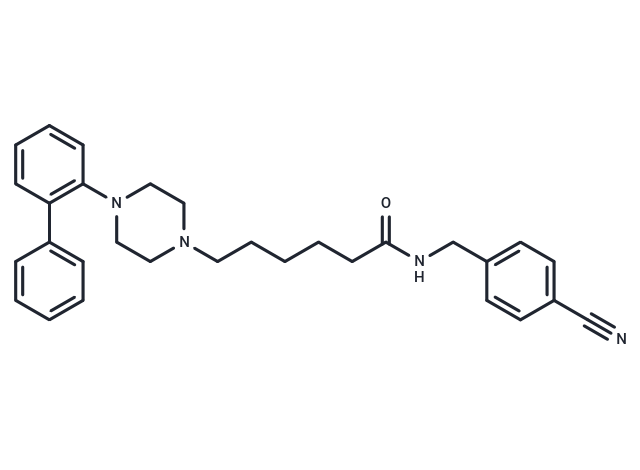Shopping Cart
- Remove All
 Your shopping cart is currently empty
Your shopping cart is currently empty

LP-211 is a brain penetrant selective agonist for a 5-HT7 receptor (Ki: 0.58 nM), and >300-fold selectivity over the 5-HT1A receptor.

| Pack Size | Price | Availability | Quantity |
|---|---|---|---|
| 2 mg | $39 | In Stock | |
| 5 mg | $64 | In Stock | |
| 10 mg | $97 | In Stock | |
| 25 mg | $189 | In Stock | |
| 50 mg | $322 | In Stock | |
| 100 mg | $513 | In Stock | |
| 200 mg | $732 | In Stock | |
| 1 mL x 10 mM (in DMSO) | $70 | In Stock |
| Description | LP-211 is a brain penetrant selective agonist for a 5-HT7 receptor (Ki: 0.58 nM), and >300-fold selectivity over the 5-HT1A receptor. |
| Targets&IC50 | D2 receptor:142 nM (Ki), 5-HT1A receptor:188 nM (Ki), 5-HT7 receptor:0.58 nM (Ki) |
| In vitro | LP-211 showed high 5-HT 7 receptor affinity (Ki = 0.58 nM), high selectivity over 5-HT 1A and D 2 receptors (324- and 245-fold, respectively), and agonist properties (maximal effect = 82%, EC 50 = 0.60 microM) [1]. Pretreatment with LP-211 had no effect on Fos-like immunoreactivity but strongly increased the response produced by capsaicin [2]. |
| In vivo | After intraperitoneal injection in mice, LP-211 (10 mg/kg) rapidly reached the systemic circulation and entered the brain. Its brain concentration-time profile paralleled that in plasma [1]. SCI rats responded to LP-211 (0.003-0.3, mg/kg, i.v.) with dose-dependent increases in bladder capacity and residual volume [3]. LP-211 reduced synaptic integration in layer 5 pyramidal neurons, which was enhanced in neuropathic pain due to a dysfunction of dendritic hyperpolarization-activated-and-cyclic-nucleotide-regulated (HCN) channels [4]. |
| Kinase Assay | Human 5-HT1A serotonin receptors stably expressed in HEK293 cells were radiolabeled with 1.0 nM [3H]-8-OH-DPAT. Samples containing 40 μg of membrane protein and different concentrations of each compound ranging from 0.1 nM to 10 μM were incubated in a final volume of 500 μL of 50 mM Tris-HCl pH 7.4, 5 mM MgSO4 for 120 min at 37 °C. After this incubation time, samples were filtered through GF/C presoaked in polyethylenimine 0.5% for at least 30 min prior to use. The filters were washed twice with 1 mL of ice-cold buffer (50 mM Tris-HCl, pH 7.4). Nonspecific binding was determined in the presence of 10 μM 5-HT [1]. |
| Animal Research | Mice were given the test compounds intraperitoneally (10 mg/kg) and were killed by decapitation at various times thereafter. Mixed arteriovenous trunk blood was collected in heparinized tubes, centrifuged at 3000g for 10 min, and the plasma was stored at -20 °C. Brain was removed immediately, blotted with paper to remove surface blood, and quickly frozen in dry ice. Compounds and their 1-arylpiperazine metabolites were extracted from plasma and brain homogenate and quantified by reversed-phase HPLC with UV detection (230 nm). Briefly: to 0.1 mL of plasma, 0.2 mL of 20 mM of ammonium bicarbonate and 0.02 mL of a methanolic solution of the internal standard (100 μg/mL) were added; samples were then extracted twice with 1.5 mL of hexane containing 1% of isoamyl alcohol, and the combined extracts were evaporated to dryness and reconstituted in 0.15 mL of the mobile phase, which was injected into the chromatographic column. Brain tissue was homogenized in distilled water (1 g/10 mL), and 1 mL of the homogenate was extracted twice with 1.5 mL of hexane/isoamyl alcohol as described for plasma. Then, the organic phase was shaken with 0.2 mL of the mobile phase (LP-211 only); after centrifugation, 0.1 mL of the aqueous phase was injected into the chromatographic column [1]. |
| Molecular Weight | 466.62 |
| Formula | C30H34N4O |
| Cas No. | 1052147-86-0 |
| Smiles | C(CCCCC(NCC1=CC=C(C#N)C=C1)=O)N2CCN(C3=C(C=CC=C3)C4=CC=CC=C4)CC2 |
| Relative Density. | 1.17 g/cm3 (Predicted) |
| Storage | Powder: -20°C for 3 years | In solvent: -80°C for 1 year | Shipping with blue ice. | |||||||||||||||||||||||||||||||||||
| Solubility Information | DMSO: 90 mg/mL (192.87 mM) | |||||||||||||||||||||||||||||||||||
Solution Preparation Table | ||||||||||||||||||||||||||||||||||||
DMSO
| ||||||||||||||||||||||||||||||||||||

Copyright © 2015-2024 TargetMol Chemicals Inc. All Rights Reserved.